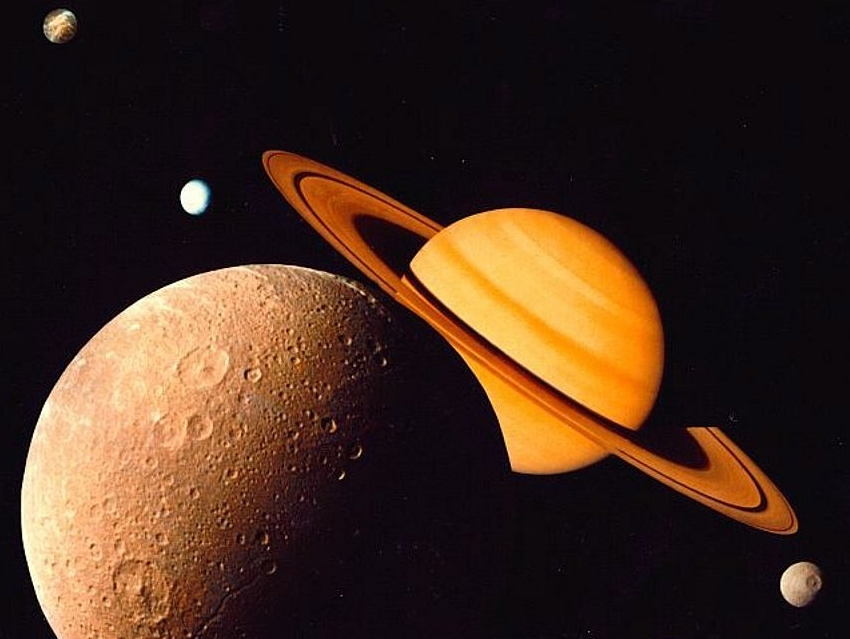Many solid objects in space are covered with dark material, which is probably of organic origin. On Titan, Saturn’s largest moon, dunes made of organic substances have been observed, but their exact composition and how the organic compounds are formed is still unclear. Scientists have discovered that solid acetylene persisting on Titan’s surface can stepwise convert in stages into polycyclic aromatic hydrocarbons. The findings shed light on the origins of carbonic structures found in space and may even provide clues to the origin of organic compounds that are essential for life on Earth.
Titan’s Dark Dunes
Titan’s landscapes, surface structures, and even weather are remarkably similar to those on Earth. This distant world has deserts, mountains, and grand lakes of its own, and a thick atmosphere with clouds and rain. However, the chemical composition of these structures is very different from those on Earth as hydrocarbons make up part of the solid, most of the liquid, and some of the gaseous components. Titan’s surface is so cold that even small hydrocarbons exist in liquid or even solid phase where they form hydrates with ice.
Yet, the exact composition of Titan’s solid surface is unknown. In the equator region, vast dunes about a hundred meters high dominate the landscape, which were documented by the Cassini-Huygens spacecraft mission as being formed of tiny grains just fractions of a millimeter in size and with the spectrographic signature of dark organic matter. Organic chemists would happily recognize such “dark organic matter of various chemical composition” as polycyclic aromatics, but on a Titan moon, shielded by a thick atmosphere, such attributions are not easily made. And if the dunes are indeed made of polycyclic aromatic hydrocarbons, how are they formed and why do they occur in such a large quantity?
To simulate a possible scenario of the chemistry in these dunes, physical chemist Ralf Kaiser, W. M. Keck Research Laboratory in Astrochemistry at the University of Hawaii at Manoa, Honolulu, USA, and his team sent energetic electrons into solid acetylene a few Kelvin above absolute zero. Acetylene ice has been identified by the Cassini spacecraft in the region of the dark dunes. High-energetic cosmic rays would leave energetic secondary electrons on the surface. The scientists proposed that these electrons would carry enough energy to provoke chemical reactions. At least over geological timescales even reactions with a high kinetic barrier, such as the stepwise annulation of three molecules of acetylene to benzene, could take place.
Solid-State Reactions, not Gas-Phase Ones
As revealed by infrared and UV spectroscopies and mass spectrometry, the frozen irradiated acetylene was converted into benzene, phenylacetylene, and styrene molecules – possible building blocks of the organic dune material. The condensed ring systems of naphthalene and phenanthrene were also found, but no anthracene.
These findings shed new light on the possible chemistries on Titan’s surface. Irradiation-induced chemical reactions had only been known in the atmosphere in which methyl radicals combine to form small hydrocarbons, which fall to the ground as rain. In contrast, Kaiser and his team demonstrated that solid acetylene can annulate form aromatics ranging in sizes from benzene to phenanthrene and possibly even more complex structures.
These reactions could also explain other observations of dark surfaces on space objects such as the comet Churyumov-Gerasimenko or the Kuiper belt object Makemake. Astronomers had argued that these bodies contain polycyclic hydrocarbons, possibly formed from acetylene ice and cosmic irradiation. Kaiser and his team have shown that this formation route may be relevant.
The researchers point out that their findings may also extend to the synthetic origin of nitrogen-containing heteroaromatics such as the nucleobases. These are essential components of life and theoretically made up by stepwise annulation of hydrogen cyanide in a similar manner to that of acetylene. Such reactions are possible on the surface of space objects, the researchers suggest.
- M. J. Abplanalp, R. Frigge, R. I. Kaiser, Low-temperature synthesis of polycyclic aromatic hydrocarbons in Titan’s surface ices and on airless bodies, Sci. Adv. 2019. https://doi.org/10.1126/sciadv.aaw5841




